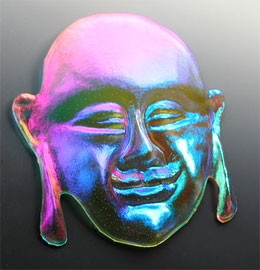Recently I have done some work using this technique, and thanks must go to a number of very experienced members of a couple of forums who have contributed their tips, techniques and experiences. The forums are: www.talkcrafts.co.uk & www.ukstampers.co.uk .
There are a few schools of thought about the technique and the resultant pieces of work can vary considerably dependent on how it is done.
The effect is achieved by applying acrylic floor finish to acetate. Layering this with tissue paper with the addition of coloured inks and glitter/pearl powders. The number of layers depend on the effect that you wish to achieve. Finally the front of the acetate can be stamped with a stamp of your choice and Stazon Ink.
Briefly the medium to use is 'Klear' floor finish made by Johnson Wax. Yes, it seems weird but that is what you need to use. It comes in a 500ml bottle which goes quite a way (and you can also use it on floors too !!!!).
Materials required:
Acetate
Masking tape
'Klear' floor finish
White tissue paper
Glitters & Pearl powder
Wide soft brush
Alcohol Inks or Dye Ink re-inkers
Stamps and Stazon pads
- Start by taking a piece of acetate, A5 size is most workable but you can use A4 if you like. Using the masking tape seal around the edges of the acetate to securely attach it to a piece of scrap paper/card (some use an old telephone directory - tearing off a few sheets after use). It is important that you completely seal the acetate against this surface because you don't want any of the 'Klear' to run under and onto the front of the acetate.

- Then apply by brush (or just pour using the lid off the 'Klear') a small puddle of clear onto the acetate and spread this all over and up to the edge of the masking tape. Now at this stage you can add a sprinkling of glitter or pearl powder, but be sparing with it. It is also possible to add these extras after the first tissue has been placed.
- Next cut a piece of white tissue paper slightly larger than your acetate and crumple it up into a ball. Carefully unfold the tissue and place this on top of the wetted acetate and glitter. Add some more 'Klear' and ensure that the bubbles are brushed out from under the tissue. Do this carefully or you may tear the tissue. If you do then patch the hole with a small piece of tissue and 'Klear'. The idea is to leave the wrinkles in the tissue but remove the air bubbles.

- Now add your coloured ink by dripping onto the wet surface and finally blending the edges of the colour drops with a brush. Be careful not to overwork as the colour will become muddy. You can also add a little more 'Klear' to assist with this.

- Add more layers of tissue and colour if you wish. I find that a few layers with very light colours give the best effect.
- Finally allow to air dry. Time for this depends on ambient conditions but usually around 30 minutes

Some like to apply heat from a heat gun to speed up the drying process, but in my experience this can effect the acetate and also crystallise the finish which will then separate from the acetate and ruin the effect.
When completely dry carefully cut around the inner edge of the masking tape with scissors or a craft knife and remove the acetate. You should then see your finished effect in all its glory. The right side is the shiny side of the acetate.
The A5 piece can then be stamped on its front surface with any colour Stazon with the stamp of your choice. This also allows you to choose the bit of the background pattern which appeals to you. Some say that you should stamp the acetate before you attach it at step 1, but I think this then limits your choice of where to stamp against the coloured effect. This can then be cut out from the A5 sheet and the rest saved for future use.
If you spill 'Klear' or allow it to dry on a surface it can be difficult to remove. Recommended method is to use dilute household ammonia and soak it for a minute or two. This will dissolve the acrylic and allow its safe removal. You may also smell ammonia when you use the 'Klear' as it is a component of the finish.
The following pics are of a few effects I have achieved. Nice to use on aperture cards or against a metallic background. These pics have been taken against a white background in each case.
some stamping has been done on this one.
Good luck with the technique. Please let me know how you go on or forward your tips on the technique. Happy Crafting !!!
Pin It






































.png)











